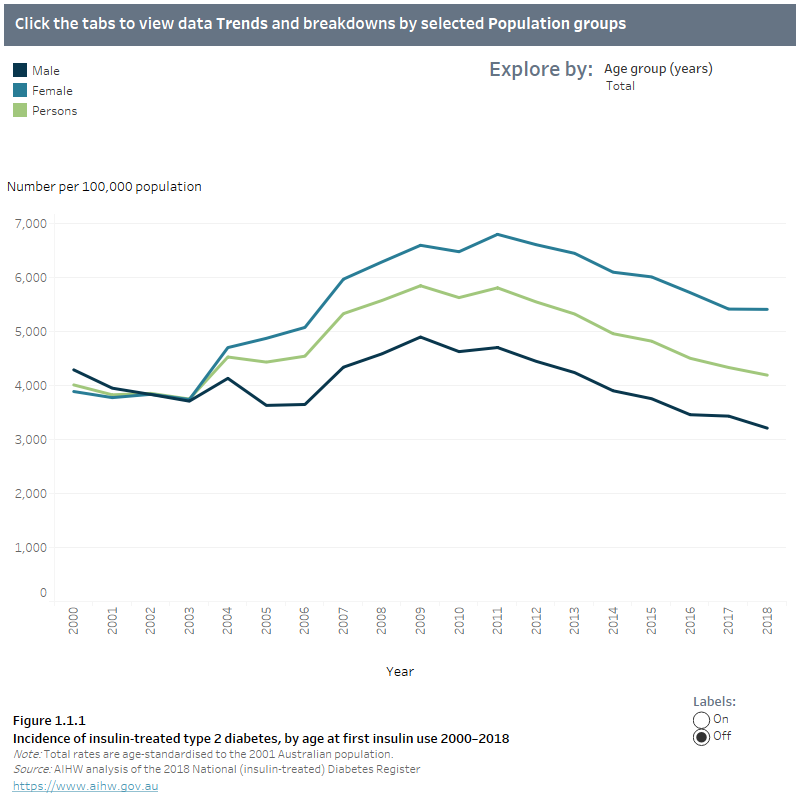Indicator 1.1 Incidence of type 2 diabetes
Considerations
There are currently no complete, national estimates of the incidence of type 2 diabetes in Australia. Part of the picture is available from the National (insulin-treated) Diabetes Register (NDR) which provides information regarding the incidence of insulin-treated type 2 diabetes. Only a proportion of people with type 2 diabetes require insulin treatment; and those who do not are excluded from the NDR. The NDR is derived from two primary data sources: the National Diabetes Services Scheme (NDSS) and the Australasian Paediatric Endocrine Group. Further data development work, including linkage to both the NDSS and other national data sets, will improve the ability to accurately report the incidence of type 2 diabetes.
Overview
In 2018, there were almost 17,000 new cases of insulin-treated type 2 diabetes recorded on the NDR—2,000 cases per 100,000 registrants with type 2 diabetes not previously using insulin.
Trends
Age-standardised incidence rates fluctuated between 3,800 and 4,500 per 100,000 population from 2000 to 2006, before rising to a peak of 5,800 cases per 100,000 registrants with type 2 diabetes in both 2009 and 2011. From 2011 onwards, age-standardised incidence rates declined to 4,200 cases per 100,000 registrants with type 2 diabetes in 2018 (Figure 1.1.1).
Age and sex
In 2018, the incidence of insulin-treated type 2 diabetes was highest in those aged 10–39 years (6,200 cases per 100,000 registrants with type 2 diabetes). After adjusting for age, the incidence was 1.7 times higher in females than males (5,400 and 3,200 cases per 100,000 registrants respectively) (Figure 1.1.1).
Population groups
In 2018, the incidence of insulin-treated type 2 diabetes was similar by socioeconomic area while rates were more than twice as high among people living in Major cities as those living in Remote and very remote areas (4,300 and 2,100 cases per 100,000 registrants with type 2 diabetes, respectively) (Figure 1.1.2). However, it is important to note that the NDR may have a lower coverage rate of people living in Remote and very remote areas and, as a result, the true incidence in these population groups may be underestimated (AIHW 2020).
State and territory
In 2018, the incidence rate of insulin-treated type 2 diabetes was lowest in the Northern Territory, with 1,500 cases per 100,000 registrants with type 2 diabetes. Incidence rates were highest in Victoria, with 4,700 cases per 100,000 registrants with type 2 diabetes. Other states had rates ranging from 3,300 to 4,500 cases per 100,000 registrants with type 2 diabetes.
Aboriginal and Torres Strait Islander people
As the NDR potentially underestimates the number of Aboriginal and Torres Strait Islander registrants with diabetes, the incidence of insulin-treated type 2 diabetes by Indigenous status has not been reported. This is an important data gap for future development. For more information, see the Methods and classifications page of AIHW's Incidence of insulin-treated diabetes in Australia web report.
About the data
The NDR is derived from two primary data sources: the National Diabetes Services Scheme (NDSS) and the Australasian Paediatric Endocrine Group. The NDSS provides access to diabetes self-management information, services, and subsidised products. Coverage of the Australian population with type 2 diabetes registered with the NDSS is unknown, as not all people with type 2 diabetes need insulin treatment or register with the NDSS. However given the incentives that the NDSS provides to people with diabetes, the NDR assumes that the NDSS captures a high proportion of people with type 2 diabetes in Australia and can provide an estimate of the incidence of type 2 diabetes.
Incidence rates were calculated based on the population including all people with type 2 diabetes who have never used insulin, and are registered with the NDSS. The method aims to provide accurate estimates of the incidence of insulin use among the population at risk—people with type 2 diabetes. Breakdowns by Indigenous status not available due to data quality issues.
Explore the data
1.1 Incidence of insulin-treated type 2 diabetes, by age at first insulin use 2000–2018 and selected population groups, 2018
Trends figure 1.1.1 shows the trend in incidence of insulin-treated type 2 diabetes by age and sex from 2000 to 2018. Rates peaked for males in 2009 at 4,895 per 100,000 population and for females in 2011 at 6,796 per 100,000 population. Rates have declined gradually since then for both males and females. In 2018, there were 3,209 and 5,407 new cases of insulin-treated type 2 diabetes among males and females, respectively. In 2018, for both males and females, incidence rates were highest in the 10–39 age group.
Population group figure 1.1.2 shows the incidence of insulin-treated type 2 diabetes, by selected population groups in 2018. Rates were higher among females than males with 5,407 and 3,209 per 100,000 population, respectively. Rates were similar by socioeconomic area, yet more than 2 times as high in Major cities as Remote and very remote areas. Among the states and territories, rates were highest in Victoria (4,699 per 100,000 population) and lowest in the Northern Territory (1,525 per 100,000 population).

| Definition | Data source | |
|---|---|---|
|
Numerator |
Number of people with newly diagnosed type 2 diabetes who require insulin. |
AIHW National (insulin-treated) Diabetes Register (NDR) 2018 |
|
Denominator |
Number of people with type 2 diabetes who have never used insulin, and are registered with the National Diabetes Services Scheme (NDSS). |
NDSS |
References
Australian Institute of Health and Welfare (AIHW) 2020. The National (insulin-treated) Diabetes Register 2018; Quality Statement. Canberra: AIHW. Viewed 13 July 2020.


